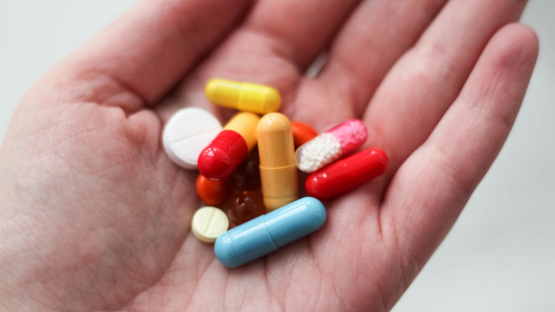"We were taking a justified risk." Neonatologist Sergey Kachan has been saving the smallest patients for 30 years

More than 40 years in medicine, 30 of which he has been the head of the department of anesthesiology and resuscitation for newborns of the Clinical Maternity Hospital of the Minsk Region. Every year, hundreds of the smallest patients pass through the hands of Sergei Kachan, Honored DOCTOR of Belarus. Many amazing stories of saving babies are associated with the name of this particular doctor. Sergey Edmundovich told BelTA about medical miracles, his professional path, the new building and plans for the future in an interview, the reason for which was his victory in the Doctor of the Year competition in the Best Pediatrician nomination.
- Sergey Edmundovich, I know that you are from a medical family. Tell us about your professional path.
- My parents were also doctors: my father was an obstetrician-gynecologist, my mother was a phthisiatrician-radiologist. it is quite logical that I continued the medical dynasty. In 1982 he graduated from the Minsk State Medical Institute and, together with his wife, went to work on distribution in a small town in the Grodno region - Dyatlovo. At first he was the head of the pediatric department of the district hospital, then - the district pediatrician, and in 1986 he entered the Research Institute for the Protection of Motherhood and Childhood (now it is the Republican Scientific and Practical Center "Mother and Child"), where he worked as a junior researcher until 1990. . And the maternity hospital in the Minsk region was a scientific base.
Having devoted some part of my life to science, I realized that practical medicine interests me more. And almost with a finished dissertation, he went to the maternity hospital to manage the department of the second stage of nursing premature babies. Just opened a new building, which is now under reconstruction. In 1991, he got an internship in Germany, where he realized that neonatology is, first of all, intensive care. I was carried away by new technologies, I wanted to change a lot in my maternity hospital. Upon his return, the head physician offered to manage another department - intensive care. This went on for some time, but later decided not to scatter forces. Since the end of 1993 I have been working as the head of the department of anesthesiology and resuscitation for newborns.
It turns out that I have been in medicine for 40 years, of which 30 I have been in charge of resuscitation. During this time, he twice went on an internship in Germany. And today I can say with confidence that our technologies are in fact not inferior to European ones. Our indicators are good. Thanks to the developed programs, we have no throwing: any doctor knows what to do in a given situation.
Despite my great experience, I am obliged to constantly improve, as I teach at the Department of Pediatric Anesthesiology and Resuscitation of BelMAPO and work with pediatric anesthesiologists-resuscitators. Agree, no one is interested in listening to what you already know. Therefore, in my schedule - constant work with literature. We force interns to study foreign literature. Articles are translated into Russian and entered into a common database. And these materials can be used by any doctor of the department.
- Tell us about the results of the department's work.
- I consider it a great achievement that for more than ten years the mortality rate in the intensive care unit has been less than 1%. For departments of this type, which treat the most severe newborns, this is an indicative result. Not a single child died in 2022. The survival rate of children with extremely low and very low body weight last year was 100%, in 2021 it is above 90%.
- What are the reasons for such indicators?
- First of all, the professional work of all medical and nursing staff. Our doctors learn not only from courses, but also from colleagues. We accumulate knowledge, we are interested in new methods, including those from foreign literature and scientific articles.
By the way, in our department - one hundred percent complete set of doctors. Not every intensive care unit can boast of this. We are eager to work, including graduates, and we are proud of it. There are many nurses with the highest and first category - 82%, who also hold on to their jobs. The atmosphere in the team is good, there is no fuss. This allows you to look at the situation with personnel with great confidence.
It is important that a young specialist is never left alone with a difficult patient. There are always three doctors on duty, at least one of them with the highest category. There is no such situation when a young doctor deals with a serious patient and no one knows about it. Ask any doctor with experience what is happening with a heavy child, and he will answer, provide information up to the results of the tests. According to the intensive care list, we see how the treatment takes place , how appointments change, this process is discussed and controlled.
- Modern equipment is also important, right?
- We have modern incubators that allow you to create the most comfortable conditions for a newborn baby. They allow you to measure two temperatures at once - peripheral and central, which is very important for such patients. We can take care of the child in the open mode: the emitter will work from above, and the mattress will be heated from below. The department is equipped with high quality ventilators, which are considered to be among the best in the world. We can also carry out ventilation in the high-frequency ventilation mode, when gas is supplied at a frequency of, for example, 600 breaths per minute.
We have ultrasonic and X-ray diagnostic devices, equipment for laboratory research of blood gases composition. Thanks to this, we can quickly diagnose a newborn baby.
As soon as we finish the reconstruction of the building, other newest equipment will appear in the department. For example, monitors will be purchased that are used to monitor the child's condition when moving. They show blood pressure, temperature, respiratory rate, heart rate, record ECG, can help calculate the dose of drugs, they can view x-rays of the patient. All medical information about the child will be in one small monitor. For convenience, it can be connected to a large screen as a repeater. Weekly information about the child's condition enters the central database, and the doctor can see it at any time without getting up from his workplace.
There will be a new ultrasound machine, new infusion stations. We dream (the issue of the possibility of purchasing is being decided now) about a compounder that performs automated mixing of medical solutions, absolutely accurate and sterile. Thanks to him, human contact with liquids is minimized. So, the nurse is typing a program that the doctor dumps on her computer. The finished solution of a given volume and concentration is discharged into the final container - a bag or syringe. The correctness of the introduction of the solution to the patient is controlled by the infusion station. As a result of automation, errors are minimized and the risk of infection for young patients is significantly reduced.
- When will the new anesthesiology and resuscitation department for newborns open and what opportunities will it provide?
- A new department with 18 beds is planned to be put into operation by the new year. Two thirds of the equipment has already been delivered. It will be a very good building, rebuilt with the latest technological possibilities, including ventilation requirements. In the wards for newborns there will be the same sterile air as in the best operating theaters in the republic. We can adjust the temperature in any room. For example, in the wards where very small children lie, set 28 degrees Celsius, where older children - 25 degrees.
A new communication gas supply system is also provided. The solution is interesting: the columns, where medical gas and oxygen will be supplied, will move. In many cases, when additional equipment is required, this is convenient: if the child needs to perform an ultrasound, the column is moved away for a while, and after the examination it returns back. We have never had such opportunities, so we are looking forward to the opening of a new building.
In the renovated building, the flow of patients, as planned, will be as differentiated as possible. One ward will work for reception, that is, newly arrived children will come here. Those who can be switched to non-invasive ventilation or infants who need oxygen therapy can be transferred to a second room. And the third block - transitional - will be intended for children, for example, with nutritional problems and who do not need oxygen support.
- The former department had a good reputation due to the fact that mothers could be with their children. Do you plan to return to this practice?
- Now, during a large-scale reconstruction, due to the shortage of space, we cannot leave all mothers in the postpartum department. In the new building, we plan to return to the practice of cohabitation.
Psychological contact with the mother for newborn babies is very important. In the building where we were previously, the women always stayed in the maternity hospital next to the children. Mom every day talked with the child, who was in intensive care. This approach reduced stress levels. The woman saw that planned work was going on, and understanding this relieved nervousness, the family calmed down. And we were more relaxed. The fact is that most of the work, especially in the first days after the patient's admission, consists in communicating with the mother and parents.
Since the mother was able to bring breast MILK to her child every day , the children in our department had significantly fewer bowel problems. And after the transfer from intensive care, the mother participated in the care of her baby with the help of a nurse, and this was an educational moment. We have a regional maternity hospital, mostly there are women from rural areas, many of whom lack knowledge about child care. And after watching the professionals, a woman, after being discharged from the hospital, no longer thinks of feeding her baby with cow's milk, as her grandmother would advise.
- What unique cases lately are remembered?
- We work so long that sometimes we do not notice the uniqueness in those cases that really seem unusual. Literally before your arrival, they remembered a baby who was born with a weight of 760 g. Parents sent a video in which a child of one and a half years old says hello to us. It seems nothing unique, if you do not remember with what difficulty we managed to get this baby out. He had a severe syndrome of respiratory disorders, the child was associated with a ventilator for a long time. We were afraid that he would develop bronchopulmonary dysplasia. Fortunately, everything worked out.
I remember admiring the photographs of a child who, at 9 months old, was actively moving and crawling. And the baby was born with a weight of only 640 g.
Уникален случай, произошедший года четыре назад. Ребенку с тахикардией никак не удавалось нормализовать сердечный ритм. Лекарственные препараты не помогали. Малыш буквально умирал. Кардиоверсию, которую обычно делают взрослым, провести было сложно, поскольку аппаратов (дефибрилляторов) для новорожденных нет. Нам удалось найти дефибриллятор, предназначенный для детей от пяти лет. Используя этот прибор, в определенной степени мы рисковали, но риск был оправданным. В целом у новорожденных кардиоверсию проводят крайне редко. По сути, мы использовали последний шанс. К счастью, ритм нормализовали.
Subsequently, the heart rhythm still broke a little, but it was already amenable to drug treatment. The child is still under the supervision of cardiologists. Against the background of drug therapy, fortunately, the rhythm has been stable for four years now, the child lives a full life.
- What do you personally feel when grateful parents send you photos and videos of their children?
- That's what we're working for. When these photos and videos come to you, you remember specific cases, that concentration of work and attention of the whole team - and you thank fate that you have a very interesting job. She is so versatile. I can’t even imagine what other specialty has so many facets.
- How do you see the future of Belarusian neonatology?
- Let's remember 2007-2008, when the first large purchase of very good artificial lung ventilation devices for newborns and incubators for the whole republic went on. We took a completely new look at our capabilities. This was a very serious step forward for all clinics that care for newborns. HEALTH workers quickly learned how to use the equipment, and as a result, neonatal death rates dropped dramatically.
It would seem, why such high-quality incubators are needed, if the old ones also worked and kept the temperature. But success is shaped by the little things. A child weighing 700 g needs a heated mattress. Heat must also come from above, even when closed. The physiological laying of the baby is important, that is, the ability to imitate the intrauterine position. The function of convection inside the incubator is also needed: if the child overheats, you can quickly air-condition the incubator without opening the doors and without lowering the temperature.
Modern models of ventilators allow you to measure the level of carbon dioxide in exhaled air, the results are visible on the monitor. Thanks to this, we do not take an extra blood sample to see the composition of the gases, which means we do not injure the baby. Any invasive procedure is pain , stress for a child, especially a premature one. These features may seem small, but they create a more comfortable environment for the patient and facilitate the work of the staff.
New models of ventilators have a number of other advantages that shape the quality of care. For example, a special sensor on the arm allows you to measure blood oxygen saturation, the so-called saturation. In case of deviations, the device automatically controls the oxygen supply to the newborn and notifies the nurse about this. As you know, not only hypoxia is harmful to a child, but also hyperoxia. Excess oxygen in the body adversely affects the lungs and retina.
By the way, in the future, a retinocamera will appear in our department. We won't have to take premature babies to the eye department. We can track changes in the retina right on the spot. I think ophthalmologists will meet halfway and will carry out all the necessary procedures with us.
The new department will be able to determine the noise level in the wards. In addition, in the wards where sick newborns will be nursed, there will almost always be twilight lighting, except for the hours intended for feeding children. Our task is to make it dark, calm, quiet, that is, to create conditions similar to those in utero.
And if after 2007-2008 we largely changed the situation in mortality, at this stage we want to reduce disability. Today we strive not only for the child to survive. We try to insure patients as much as possible from complications in the future, and nursing is aimed at this. Thanks to the purchase of ultra-modern equipment and staff training, neonatal care will rise several steps higher.
BELTA.
Photo by Nadezhda Andreichik
Read together with it:
- Progress Agro presented two cloned calves in the Krasnodar region.According to Sergey Yakovenko, HEAD of the Altragene laboratory, large fetuses are a common problem in cloning, and researchers are continuing to work to reduce this risk. Previously, culture media containing bovine serum containing growth factors could contribute to increased calf weight. Now, a synthetic medium is being used, which has shown positive results. All newbornsThe calves were manually...
- ФАО: мировые цены на продовольствие снижаются второй месяц подрядДжим Вайкофф Среднее значение Индекса цен на продовольствие ФАО в октябре составило 126,4 пункта, снизившись с пересмотренного значения в 128,5 пункта в сентябре, что представляет собой небольшое снижение в годовом исчислении и на 21,1% ниже пикового значения в марте 2022 года. Лидером снижения стал сахар: его субиндекс упал на 5,3% до самого низкого уровня с декабря 2......
- "Истинный полешук" Русый рассказал, как нарушил стиль работы на совещании у ПрезидентаМихаил Русый 18 ноября, Минск. Александр Лукашенко 18 ноября собрал совещание по темам развития районов Припятского Полесья и реализации соответствующей программы. Основным докладчиком на мероприятии выступил Михаил Русый - "истинный полешук", как назвал его Президент, уполномоченный представитель главы государства в Брестской области и председатель Постоянной комиссии по законодательству и госуда...
- Ученые Беларуси разработали новый ветеринарный препарат для лечения заболеваний крупного рогатого скотаНовый препарат, названный «Антипестивир-ВД», стал первым противовирусным средством на рынке, эффективным против болезней слизистых у коров, включая скрытые формы инфекции. В состав препарата входят компоненты, произведенные из местного сырья, которые активируют иммунный ответ животного. На этапе клинических испытаний препарат продемонстрировал высокую эффективность: 63,3% животных выздоровели в те...
- Основатель Wolt Мики Кууси: «Платите сотрудникам больше, чем они ожидают»К 35 годам Мики Кууси дважды попал в список FORBES, создал приложение доставки Wolt, которое продал за $8 млрд, превратил локальную конференцию Slush в один из крупнейших технологических форумов Европы. Вот каких принципов он придерживается «В жизни есть много вещей, которые нам просто приходится делать, например есть. И время — единственная валюта, которую мы не можем вернуть… Это не вопрос лени,...
- Россельхознадзор выявил 29 нарушений в пищевой продукции Вологодской областиСтруктура нарушений: Мясо и мясная продукция: 12 нарушений Молочная продукция: 6 нарушений Рыба и рыбная продукция: 6 нарушений Мед: 2 нарушения Корма: 3 нарушения Все случаи нарушений были зафиксированы в системе раннего оповещения «Сирано». По каждому выявленному факту предприятиям объявлены официальные предостережения о недопустимости несоблюдения обязательных требований. Проведенные лабораторн...





























































